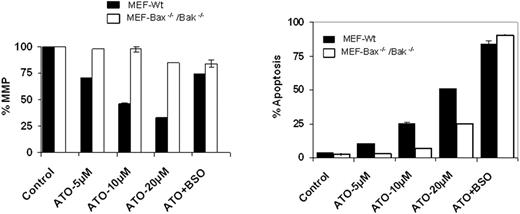Abstract
Abstract 2708
Poster Board II-684
Arsenic trioxide (ATO) induces apoptosis in cancer through several mechanisms including modulation of the redox system and targeting the BCL-2 family and mitochondria, resulting in cytochrome c release and activation of caspases. However, the mechanisms of arsenic-induced cell death in lymphoma remain to be elucidated, while methods to enhance ATO-related apoptosis have not been fully explored. In the present study, we evaluated the cytotoxic activity and pathways of cell death induced by ATO alone and in combination with a glutathione (GSH)-depleting agent in non-Hodgkin lymphoma (NHL) cell lines and primary cells from patients with lymphoma. We hypothesized that depletion of GSH would enhance ATO induced apoptosis through mitochondrial and caspase-mediated pathways.
We treated Ramos (Burkitt lymphoma), HF1 (follicular lymphoma), and SUDHL4 (diffuse large B-cell lymphoma) NHL cell lines, and primary follicular lymphoma and CLL/SLL cells with increasing concentrations (10–100μM) of ATO for 24–72 hours (hrs). Apoptosis was determined by Annexin V-Propidium iodide staining followed by flow cytometry and Z-VAD-FMK was used as a pan-caspase inhibitor. ROS was measured by H2DCFDA staining followed by flow cytometry. We further studied the mechanism of apoptosis by measuring alteration in mitochondrial membrane potential (MMP), Bax translocation, and caspase and PARP activation. In addition, we treated wild type and Bax−/−/Bak−/− double knockout mouse endothelial fibroblasts (MEFS) with ATO or ATO/BSO and determined apoptosis and mitochondrial membrane potential compared with MEF wild type (MEF-wt).
Treatment of cells with ATO resulted in dose- and time-dependent apoptosis, although high concentrations were necessary for effect (ED50 >10–20μM). ATO treatment redistributed Bax from the cytosol to mitochondria and there were significant changes in MMP, as well as increased PARP, cleaved caspse-3 and -9, while BID was downregulated. Furthermore, ATO-induced apoptosis was caspase-dependent. Addition of the GSH-depleting agent, buthionine sulfoximine (BSO), to ATO induced strong synergistic cell death (combination indices <0.1 in all cell lines), resulting in apoptosis that was ROS-related, but mitochondrial- and caspase-independent. Using immortalized wild-type MEFS and Bax−/−Bak−/− double knockouts, ATO-induced alteration in MMP and apoptosis that was Bax-dependent (see figure below), while targeted disruption of the Bax/Bak genes had no enhancing effects on ATO/BSO-induced MMP or apoptosis. Interestingly, ATO alone induced appreciable apoptosis in primary CLL/SLL and follicular lymphoma cells, while BSO had minimal additive effects in these fresh cells. This appeared due to markedly lower intracellular GSH content within primary cells compared with cell lines (p<0.001).
Altogether, our findings establish that ATO has anti-lymphoma activity and approaches to enhance its cytotoxic activity are feasible via engagement of distinct cell death mechanisms. Continued investigation of arsenic-based therapy, including new arsenical compounds and methods of tissue delivery that are able to overcome mechanisms of cellular resistance, for the treatment of lymphoma is warranted.
Gordon:Cure Tech: Membership on an entity's Board of Directors or advisory committees.
Author notes
Asterisk with author names denotes non-ASH members.


